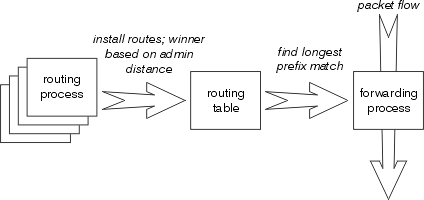IP Routing 2
Question 1
Question 2
Explanation
The administrative distance of each protocol is compared to see if that route is better or not.
Question 3
Explanation
Letter “D” is used to symbolize for EIGRP (with a default AD of 90). Letter “E” is not used for EIGRP because it has been used for Exterior Gateway Protocol (EGP). It is a obsolete routing protocol now.
Question 4
Question 5
Explanation
If there is a default route then surely the router will forward all unknown traffic to there. But if there is no default route in the routing table then the router will discard the packet. In this question we suppose there is no default route in the routing table. Otherwise the question should state it (this question is unclear).
Question 6
Question 7
Question 8
Explanation
Making a forwarding decision actually consists of three sets of processes: the routing protocols, the routing table, and the actual process which makes a forwarding decision and switches packets. The longest prefix match always wins among the routes actually installed in the routing table, while the routing protocol with the lowest administrative distance always wins when installing routes into the routing table.
Question 9
Explanation
In fact this question is not clear. If we understand that “router is unable to find a known route in the routing table” and there is no default route in the routing table then the router will surely discard the packet -> A is correct. But we are not sure if there is a default route or not so let learn more about gateway of last resort.
A Gateway of Last Resort is a route used by the router when no other known route exists to send the IP packet. For CCNA level, when ip routing feature is enabled, a gateway of last resort is usually created by:
+ The “ip default-network” command (but dynamic routing protocols have different behaviors). But in general, the “ip default-network” cannot set the gateway of last resort without a known route in the routing table.
+ Creating a static route to network 0.0.0.0 0.0.0.0 is another way to set the gateway of last resort on a router. This is the reason why this question is not clear as it does not tell us if a default route exists or not.
Maybe in this question a default route does not exist. Otherwise the author would notice and indicate it in the question.
For more information about Gateway of Last Resort, please read: http://www.cisco.com/c/en/us/support/docs/ip/routing-information-protocol-rip/16448-default.html
Question 10
Explanation
The default administrative distance value of static route is 1 which is always smaller than any dynamic routing protocol so it is always preferred to dynamic routing protocols.

 Reference:
Reference: 

Which value is indicated by the next hop in a routing table?
A. preference of the route source
B. IP address of the remote router for forwarding the packets
C. how the route was learned
D. exit interface IP address for forwarding the packets